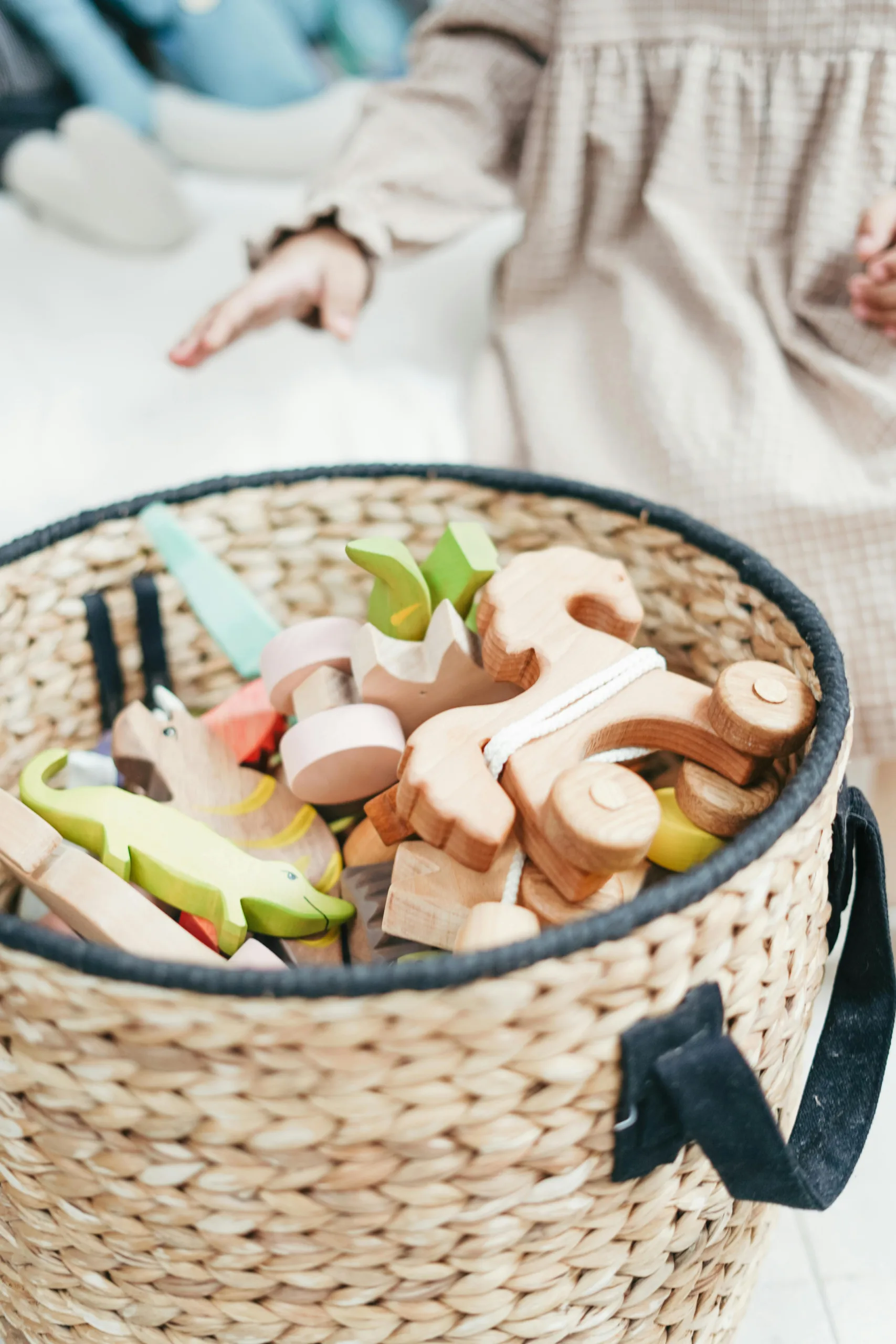Imagine stepping into a vibrant and safe space, full of stimulating, educational, and age-appropriate toys – that’s what an ideal infant classroom in a daycare should be like. The article presents with clarity the specific toys that are essential in such an environment. From interactive rattles to colorful stackers, you’ll discover the pivotal role that these items play in promoting various facets of an infant’s development. Whether you’re a new daycare founder or a parent looking to recreate the daycare experience at home, understanding the importance of these toys and how they contribute to a child’s early learning will prove beneficial. Enjoy this detailed tour through the fascinating world of daycare toys, each crafted to cater to an infant’s inquisitive mind and nimble hands.

Understanding Infant Development
When you’re caring for an infant, it’s essential to understand the various stages of their development. This knowledge allows you to provide them with the ideal environment, toys, and activities that support their growth.
Key Qualities Supporting Infant Development
In group care settings, there are four crucial qualities that nurture infants’ growth and learning:
- Child-Sized Spaces: Environments thoughtfully designed at an infant’s level encourage active exploration and foster independence.
- Flexibility: Spaces and routines that easily adapt to different activities or changing needs, allowing infants to engage in ways that suit their individual pace.
- Opportunities for Movement: Room to crawl, reach, and stretch is vital. When infants can move freely, they develop muscles, coordination, and confidence.
- Choice: Providing a variety of toys and activities empowers infants to make small decisions, boosting their curiosity and building early problem-solving skills.
By ensuring these elements are present, caregivers lay the foundation for healthy cognitive, physical, and emotional development.
Why Child-Size Spaces, Flexibility, Movement, and Choice Matter
Creating an environment tailored to infants and toddlers goes beyond stocking shelves with colorful gadgets. It’s about designing a space that genuinely nurtures their budding sense of curiosity—think small tables within reach, cozy corners for tummy time, and play areas that encourage little legs to crawl, scoot, or amble at their own pace.
Child-size spaces allow babies to explore safely and independently. Furniture and toys scaled to their proportions empower them to reach, grasp, and build confidence in their newly developing skills—whether they’re cruising along a Tiny Land soft climber or practicing stacking with chunky
Flexibility in the environment is equally crucial. Infants develop rapidly, so adaptable spaces can shift as their interests and abilities blossom. Being able to rearrange play zones or swap out toys as children grow keeps things engaging and ensures their environment supports new milestones.
Movement is central to learning at this age. Open floors for crawling, soft mats for rolling, and accessible shelves supporting pull-to-stand adventures all invite infants to use their muscles, strengthening both gross and fine motor skills. Movement is the basis for so much early exploration—whether that’s plopping down onto a cushy
Choice fosters independence. Giving infants opportunities to select their own toys—within a thoughtfully organized environment—encourages decision-making and shows them that their preferences matter. Even simple choices, like reaching for a favorite teether or banging blocks together, help infants feel confident and respected in their world.
By weaving together these key elements, you create spaces that are as inviting as they are developmentally rich—setting the stage for confident exploration and joyful discovery.
Recognizing Cognitive Stages
Cognitive development pertains to the way infants and toddlers learn and acquire knowledge. They go through several cognitive stages, from reflex-based reactions to increasingly complex methods of exploring their environment. During these early stages, infants learn to anticipate events, recall past experiences, and understand cause and effect. By observing their interaction with toys and their environment, you can gain a better understanding of their current cognitive stage.
Understanding Physical Development
Physical development during infancy involves significant milestones such as rolling, sitting, crawling, and taking their first steps. These changes don’t only affect their bodies but their interaction with the world around them as well. Providing toys that encourage physical activities can significantly contribute to their development in this area.
Importance of Social-Emotional Development
Social-emotional development is foundational in a child’s overall well-being. It includes their ability to understand and regulate their feelings, form relationships, and explore their environment. By introducing appropriate toys and activities, you can encourage positive social and emotional development.
Essential Qualities for Meeting Infant and Caregiver Needs
To truly support infants and those caring for them, a nurturing environment must prioritize four essential qualities:
- Safety: Every choice, from furniture to playthings, should keep little explorers protected from harm.
- Health: The space and materials should promote hygiene and overall well-being, ensuring infants thrive.
- Comfort: Cozy surroundings with soft lighting, soothing textures, and a peaceful atmosphere help little ones feel secure.
- Convenience: Practical layouts and accessible supplies empower caregivers to focus on the children, not on searching for essentials.
These foundational elements work together to create an environment where both infants and their caregivers feel supported and at ease.
Toys for Sensory Development
A carefully selected assortment of sensory toys can significantly contribute to an infant’s overall growth and development.
Soft Toys for Tactile Stimulation
Soft toys, such as stuffed animals or fabric blocks, provide excellent tactile stimulation. This type of toys helps infants explore different textures and shapes, improving their sense of touch.
Musical Toys for Auditory Development
Musical toys can be highly beneficial for an infant’s auditory development. Sounds of different volumes, pitches, and rhythms can stimulate babies’ listening abilities, encouraging their understanding of auditory input.
Bright and Colorful Toys for Visual Stimulation
Visual stimulation plays a crucial role in a child’s development. Bright and colorful toys can draw an infant’s attention, encouraging them to focus and track objects with their eyes. This promotes the growth of visual acuity and hand-eye coordination.

Educational Toys for Infants
Educational toys can also enhance development by teaching infants new skills.
Shape Sorters for Concept Learning
Shape sorters provide a fun and engaging way to introduce infants to shapes and concepts of matching and fitting. As your infant learns to match the right shapes with their corresponding holes, they are developing problem-solving and fine motor skills.
Easy-to-Grip Stackers for Hand-Eye Coordination
Stacking toys with easy-to-grip pieces are perfect for helping infants develop their hand-eye coordination. As they try to stack one piece atop another, they are also building their understanding of balance, spatial relation, and cause and effect.
Crib Mobiles for Visual Tracking Skills
Crib mobiles with hanging objects can captivate infants’ attention, encouraging them to track the moving items visually. This promotes the development of their visual tracking skills and spatial awareness.
Toys for Physical Development
Toys also play a crucial role in an infant’s physical development.
Rattles and Teething Toys for Oral Motor Skills
Rattles and teething toys encourage infants to explore using their mouth. This stimulation advances their oral motor skills, which are necessary for chewing and speech development.
Gym Mats and Play Tunnels for Gross Motor Skills
Infants can develop their gross motor skills by crawling, rolling, or simply moving around on a play mat or through a play tunnel. These toys promote muscle development and control.
Squeeze Toys for Fine Motor Skills
Squeeze toys can help infants develop their fine motor skills. As they grasp and squeeze these toys, they are exercising the tiny muscles in their hands.
Toys Encouraging Social-Emotional Development
Certain toys can also foster social-emotional development.
Mirror Toys for Self-Recognition
Mirror toys encourage self-recognition as infants see their reflection. Recognizing themselves in the mirror is a significant step in developing self-awareness.
Dolls and Plush Toys for Empathy and Compassion
Playing with dolls and plush toys can aid in developing empathy and compassion early on. By caring for their toys, infants can practice gentleness and nurturing behavior.
Interactive Games for Cooperative Play
Interactive games that involve turn-taking can encourage cooperative play, teaching infants the importance of sharing and waiting for their turn.

Age-Appropriate Toys for Infants
When selecting toys for your infant, it’s crucial to consider their age and development level.
Guidelines for Choosing Age-Appropriate Toys
Toys should match an infant’s abilities, interests and developmental stage. Age guidelines on toy packaging can help, but remember they’re just guidelines; every child develops at their own pace.
Recognizing Potential Hazards in Toys
Potential hazards, such as small parts or toxic materials, should always be avoided. The avoidance of such hazards ensures the safety of your infant while they’re playing.
Importance of Non-Toxic, Hypoallergenic Toys
Infants, with their developing immune systems, are especially susceptible to irritants that adults might easily tolerate. Therefore, choosing non-toxic, hypoallergenic toys is crucial to safeguard their health.
Importance of Variety in Toys
Having a variety of toys is valuable in facilitating holistic development in infants.
Benefits of a Range of Toys
A wide selection of toys allows infants to acquire a breadth of skills. Variety can also keep them engaged as their interest might shift from one toy to another.
How Variety Stimulates Different Areas of Growth
Different types of toys stimulate different areas of growth. For instance, puzzles can develop problem-solving skills, while balls can promote gross motor skills.
Role of Novelty in Toy Selection
The novelty of a new toy can captivate an infant’s interest and curiosity, which are critical for their cognitive development.
Maintaining Cleanliness of Infant Classroom Toys
Keeping toys clean and sanitary is a top priority in an infant classroom.
Best Practices for Cleaning Toys
Regular cleaning of toys using appropriate cleaners that are safe for infants can prevent the spread of germs.
Frequency of Toy Cleaning
The frequency of cleaning can depend on the type of toy and how frequently it is used. Toys frequently mouthed may need daily cleaning, while others may require less frequent attention.
Understanding Cross-Contamination Risks
Cross-contamination is a potential risk in an infant classroom. Therefore, toys should be cleaned whenever they are visibly dirty or whenUsed by an infant with a contagious illness.

Safe Storage Solutions for Infant Toys
Storing toys in a safe and efficient manner can increase their longevity and usefulness.
Easy-to-Reach Storage Options
Toys should be kept where infants can easily reach them, fostering their autonomy and exploration.
Safe Ways to Store Small Toys
Small toys should be stored in such a way that prevents infants from accidentally swallowing them.
Keeping Toys in Good Condition
Proper storage helps in maintaining the condition of the toys, keeping them safe, clean, and appealing to infants.
Creating Rotation System for Toys
Implementing a rotation system for toys can bring numerous benefits.
Benefits of a Rotation System
A rotation system increases the longevity of toys and constantly offers infants a variety of play options.
How to Implement a Rotation System
A rotation system can be as simple as storing some toys away and then swapping them out regularly.
Incorporating New and Seasonal Toys into the System
Don’t forget to incorporate new and seasonal toys into your rotation. This will ensure your infants are always exposed to fresh stimulation and learning experiences.
Professional Resources for Enhancing Infant and Toddler Classroom Environments
For professionals eager to create nurturing, developmentally appropriate spaces for infants and toddlers, a wealth of resources is just a step away.
Recommended Reading and Reference Materials
- Books and Academic Journals: Leading publications like The Creative Curriculum for Infants, Toddlers & Twos, Caring for Infants and Toddlers in Groups by
J. Ronald Lally , and articles from theNational Association for the Education of Young Children (NAEYC) offer research-based guidance on early childhood environments. - Professional Journals: Journals such as Young Children (
NAEYC ) and Zero to Three regularly feature practical strategies for optimizing classroom routines, fostering attachment, and encouraging exploration.
Online Courses and Training
A variety of online courses, such as those offered by the
Practical Toolkits and Guidelines
- Guidance Checklists and Toolkits: Resources from organizations like
ZERO TO THREE , theCenters for Disease Control and Prevention (CDC) , andChild Care Aware offer downloadable checklists for designing safe, engaging, inclusive classrooms. - Webinars and Workshops: Regularly hosted by groups such as
Teaching Strategies and theErikson Institute , these sessions focus on best practices, current research, and real-world solutions.
By tapping into these diverse resources, educators and caregivers can stay current with effective approaches, ensuring every infant classroom is a place where curiosity, safety, and joyful learning thrive.
The Playful Architects of an Infant’s World
Imagine stepping into a vibrant, cozy infant classroom where the air hums with curiosity. There’s a gentle rhythm to the space, filled with soft coos and tiny hands exploring their surroundings. At first glance, it’s a serene picture, but look closer, and you’ll realize that the toys scattered around the room are the true architects of this infant world. These aren’t just rattles, stackers, or plush animals—they’re the building blocks of early development, guiding babies through the very first steps of understanding their environment. From sensory stimulation to cognitive leaps, each toy is purposefully designed to shape how infants engage, learn, and grow.
Sensory Toys: The First World of Touch and Sound
Let’s start with the sensory toys. Soft fabrics, crinkly textures, and musical rattles are more than distractions—they’re essential tools for babies as they begin to make sense of the world through touch and sound. Think about that first encounter with a soft plush toy or a jingling rattle. To an adult, it might seem simple, but to an infant, it’s a world of discovery: how something feels, how it moves, how it sounds. These early interactions are crucial as babies learn to grasp, reach, and eventually associate their actions with outcomes. A rattle isn’t just making noise; it’s teaching cause and effect, developing fine motor skills, and sparking the earliest hints of curiosity.
Physical Development: Crawls, Rolls, and Reaches
Now, consider the toys that promote physical development—gym mats, play tunnels, and stackers. Imagine an infant rolling over for the first time, trying to reach for a colorful block just beyond their grasp. In that moment, they’re not just moving; they’re engaging their muscles, practicing coordination, and preparing for future milestones like crawling and walking. These toys offer infants the perfect blend of challenge and support, encouraging them to explore their physical limits while building strength and balance. Every roll, crawl, and grab is a step toward mastering their little bodies.
Cognitive and Social-Emotional Growth: Mirrors and Mini Friends
Then there are the toys that encourage cognitive and social-emotional growth, like mirrors and plush animals. An infant staring at their reflection in a mirror isn’t just entertained—they’re learning self-recognition, one of the earliest signs of cognitive awareness. Meanwhile, playing with dolls or stuffed animals can foster empathy and nurturing behavior, even in babies as young as six months. These toys create opportunities for infants to begin understanding emotions and relationships, laying the foundation for future social development.
Toys as Tools for Growth
In the end, the toys in an infant classroom are much more than colorful objects—they are carefully chosen tools that support each stage of a baby’s development. From tactile learning to motor skills, from social awareness to cognitive breakthroughs, every toy plays its part in shaping a child’s growth. So, the next time you see an infant grasping a rattle or gazing at a colorful mobile, remember—what looks like play is really the first chapter in their lifelong journey of learning.

